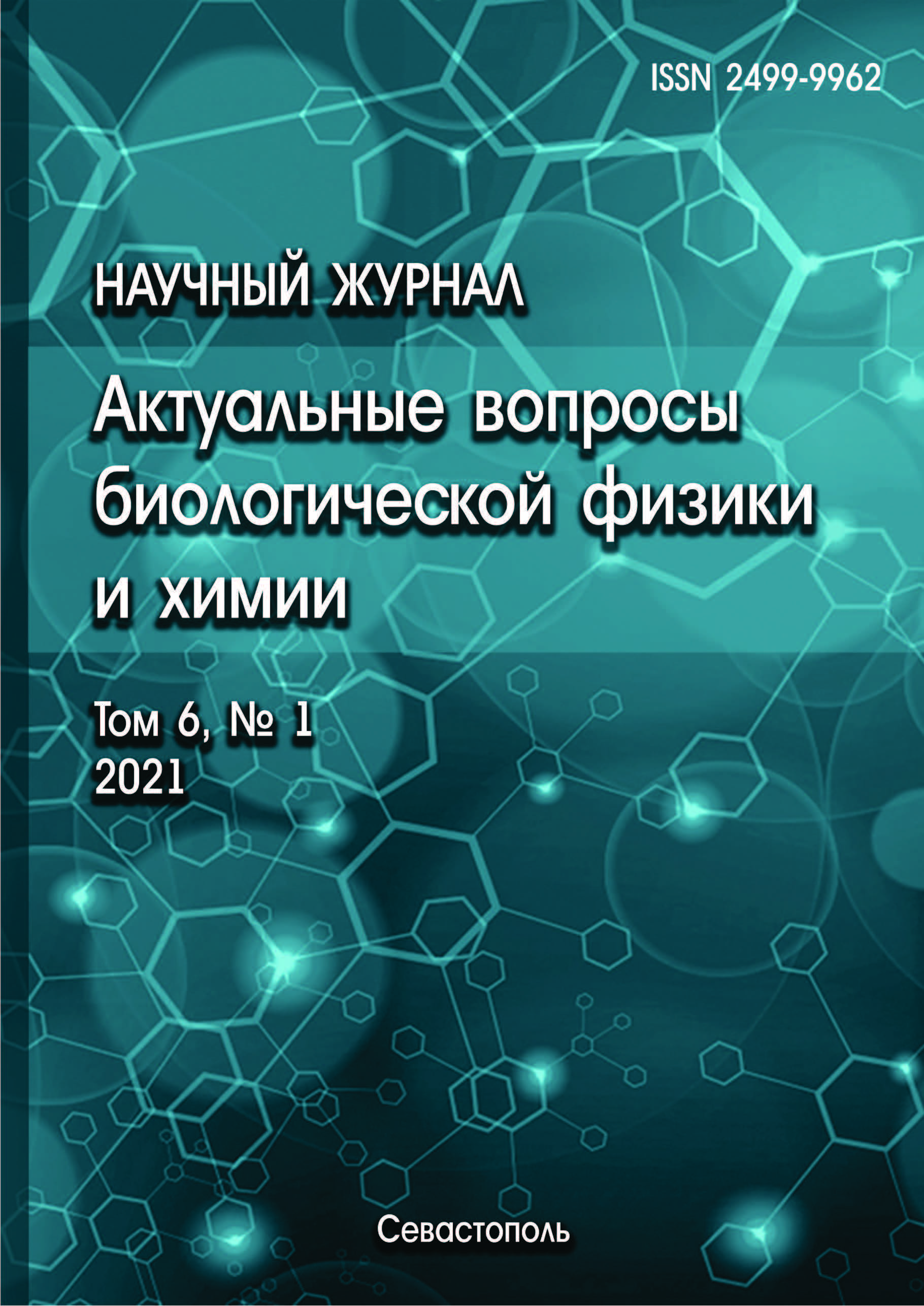Moscow, Moscow, Russian Federation
Moscow, Moscow, Russian Federation
0.2 M solutions of sodium chloride, potassium chloride, and acetone were simultaneously diluted by water with shaking to a dilution of 15C - a hundredfold dilution made 15 times. As a control, we used the initial purified water without any treatment, as well as water repeatedly poured from a test tube into a test tube before measurement (dynamized water). In addition, we investigated water diluted with water up to the fifteenth centesimal dilution (H2O-15C). Fluorescence (lex = 260 nm), Rayleigh light scattering (lex = lobs. = 260 nm), electrical conductivity, redox potential and its jump after two minutes of ultraviolet (UV) irradiation of these samples were studied. It was shown by the method of flicker noise spectroscopy that the most abrupt changes in the state of water systems occur with a similar set of frequencies in the millihertz range, but with different amplitudes and ratios of the contribution of individual frequencies. After preparation and at least for the next two days, the systems NaCl-15C, KCl-15C, and C3H6O-15C significantly differ from each other and from water in terms of the redox potential values and the redox potential jump as a result of UV irradiation. UV irradiation results in different changes in conductivity for these systems over time. The observed effects reflect the dynamics of reactive oxygen species formed during the dilution and shaking of each of the aqueous systems,
highly diluted aqueous systems, reactive oxygen and water forms (ROS), redox potential, electrical conductivity, UV irradiation
1. Voeikov V.L. Reactive Oxygen Species, Water, Photons and Life. Rivista di Biologia, Biology Forum, 2001, vol. 94, pp.193-214
2. Belovolova L.V. Reactive Oxygen Species in Aqueous Media. (A Review) Optics and Spectroscopy, 2020, vol. 128, pp. 932-951. DOI:https://doi.org/10.1134/S0030400X20070036. EDN: https://elibrary.ru/HVFYTO
3. Stavrovskaya I.G., Sirota T.V., Saakyan I.R., Kondrashova M.N. Optimizaciya energozavisimyh processov v mitohondriyah pecheni i mozga krys posle vdyhaniya otricatel'nyh aeroionov. Biofizika, 1998, t. 43, vyp. 5, s. 766-771. @@Stavrovskaya I.G., Sirota T.V., Sahakyan I.R., Kondrashova M.N. Optimization of volatile processes in the mitochondria of the liver and brain of rats after inhalation of negative air ions. Biophys., 1998, vol. 43, no. 5, pp. 766-771. (In Russ.)
4. Gudkov S.V., Bruskov V.I., Astashev M.E., Chernikov A.V., Yaguzhinsky L.S., Zakharov S.D. Oxygen-Dependent Auto-Oscillations of Water Luminescence Triggered by the 1264 nm Radiation. J. Chem. Phys. B, 2011, vol. 115, rr. 7693-7698. www.biophys.ru/archive/h2o-00022.pdf
5. Belovolova L.V., Glushkov M.V., Vinogradov E.A. Influence of Dissolved Gases on Highly Diluted Aqueous Media. Biophys., 2014, vol. 59, no. 4, rr.524-530. DOI:https://doi.org/10.1134/S0006350914040046. EDN: https://elibrary.ru/UFGCRJ
6. Bruskov V.I., Masalimov Zh.K., Chernikov A.V. Obrazovanie aktivnyh form kisloroda pod deystviem tepla pri vosstanovlenii rastvorennogo kisloroda vozduha. DAN, 2001, t. 381, № 2, s. 262-264. @@Bruskov V.I., Masalimov Zh.K., Chernikov A.V. Formation of reactive oxygen species under the action of heat during the reduction of dissolved oxygen in the air. Dokl. Acad. Sci., 2001, vol. 381, no. 2, pp. 262-264. (In Russ.)
7. Bruskov V.I., Masalimov Zh.K., Chernikov A.V. Obrazovanie aktivnyh form kisloroda v vode pod deystviem tepla. DAN, 2002, t. 384, № 6, s. 821-824. @@Bruskov V.I., Masalimov Zh.K., Chernikov A.V. Formation of reactive oxygen species in water under the action of heat. Dokl. Acad. Sci., 2002, vol. 384, no. 6, pp. 821-824. (In Russ.)
8. Voeykov V.L. Blagotvornaya rol' aktivnyh form kisloroda. “MIS-RT”-2001g. Sbornik № 24-1, Nauchno-issledovatel'skiy centr «IKAR». @@Voeikov V.L. The beneficial role of reactive oxygen species "MIS-RT"-2001. Collection No. 24-1, Research Center "IKAR". (In Russ.)
9. Do Min' Ha, Muhitova O.G., Vilenskaya N.D., Malyshenko S.I., Voeykov V.L. Aktivirovannye perekis'yu vodoroda vodnye rastvory bikarbonatov - dolgovremennye istochniki nizkointensivnogo izlucheniya, reagiruyuschie na slabye i sverhslabye vozdeystviya. Biomed. Radioelektronika, 2011 t. 2, s. 28-38. @@Do Min Ha, Mukhitova O.G., Vilenskaya N.D., Malyshenko S.I., Voeikov V.L. Hydrogen peroxide activated aqueous solutions of bicarbonates are long-term sources of low-intensity radiation that respond to weak and ultra-weak effects. Biomed. Radioelectronics, 2011, vol. 2, pp. 28-38. (In Russ.)
10. Belovolova L.V., Glushkov M.V., Vinogradov E.A. Effect of Acetone and the Probe 1-Anilino-8- Naphthalenesulfonate on Water as Estimated by Fluorescence in the UV Region. Biophys, 2011, vol. 56, no. 2, pp. 181-187. DOI:https://doi.org/10.1134/S0006350911020059. EDN: https://elibrary.ru/OHZJVN
11. Belovolova L.V., Glushkov M.V., Vinogradov E.A., Babintsev V.A., Golovanov V.I Ultraviolet fluorescence of water and highly diluted aqueous media. Phys. Wave Phenom., 2009, vol. 17, no. 1, pp. 21-31. DOI:https://doi.org/10.3103/S1541308X0901004X EDN: https://elibrary.ru/MWUHZN
12. Timashev S.F. Flikker-shumovaya spektroskopiya. Informaciya v haoticheskih signalah. M.: Fizmatlit, 2007. @@Timashev S.F. Flicker noise spectroscopy. Information in chaotic signals. Moscow: Fizmatlit, 2007. (In Russ.) EDN: https://elibrary.ru/RYRTPR










